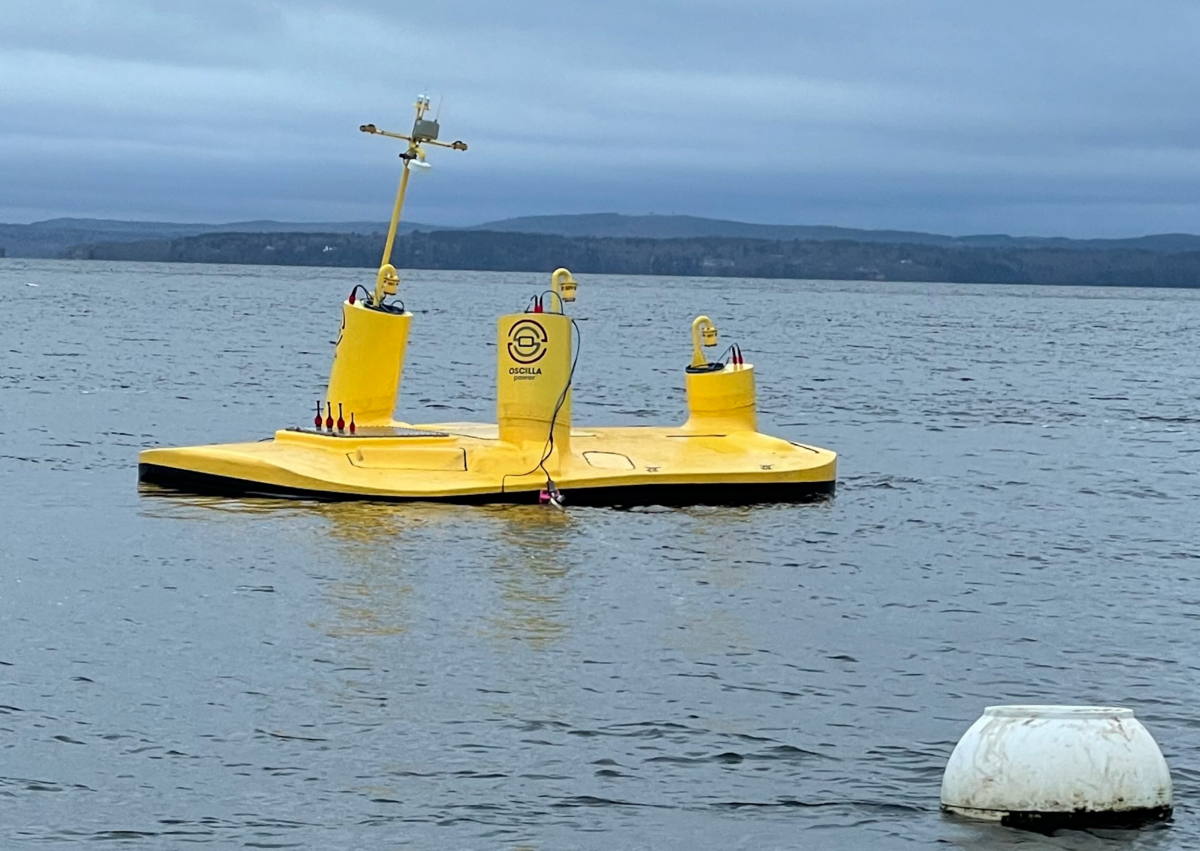Oscilla Power, a wave energy conversion technology developer founded in 2009 in Seattle, announced it has deployed a prototype of its Triton wave energy converter device in partnership with the Maine Maritime Academy and the University of Maine. The prototype is a 1/6 scale version of its 1 MW wave energy device.
The goal of the pilot project deployment is to confirm the design and performance of the Triton wave energy converter. A full-scale device is planned for 2024.
Triton is designed on a three-tendon architecture that enables the device to capture all degrees of freedom in a wave (heave, pitch, surge, roll, and yaw.) The device holds a multi-mode point absorber that consists of a geometrically optimized surface float connected to a ring-shaped, vertically asymmetric heave plate by three taut, flexible tendons. This unique architecture leads to greater average annual energy production and increased energy capture over a wide range of ocean conditions.
The device uses flexible tendons to connect the float to the reaction ring. This allows the use of simpler and lower-cost installation strategies than other wave energy devices, said Oscilla.
The Triton will be towed to deployment sites with the heave plate hard-mated to the bottom of the surface float. After mooring the surface float, the system is lowered to the deployment depth using temporary onboard winches. The winches are employed in reverse for heave plate recovery.
These self-deployment and self-recovery functions remove the need for specialized vessels or heavy lift equipment during installation and recovery operations, said Oscilla. Only a regular tug boat is required to tow the system and supply hydraulic power for winch operations.
Due to the unique wave conditions in the Castine Harbor testing area, the 1/6 scaled prototype unit will operate in the same manner as a full-scale unit during this 12-week test, said Oscilla. Winter wave conditions in Castine Harbor are approximately 1/6 the size of waves experienced on the U.S. west coast, providing a useful test scenario for the full-scale units.
A goal of the testing is demonstration of the ability of Triton to withstand extreme weather events and harsh wave events. The device has a unique feature where it can submerge beneath the water to protect itself from damage.
The testing will also be used to enable Oscilla to accurately predict the power that the full-scale system will generate in different wave conditions.
“While we have excellent design and computer-driven simulations, there is no substitute for running the unit through its paces in a real operating environment,” said Tim Mundon, chief technology officer for Oscilla Power. “Thanks to the partnership with Maine Maritime Academy and the University of Maine, we’re able to complete this testing to validate our assumptions and numerical models to ensure our commercial production unit will perform as designed.”
The U.S. Department of Energy’s Water Power Technologies Office has supported the company throughout its history with research grants. Ocean wave power is explored for its potential to pair with other intermittent renewables like solar and wind. DOE representatives were on-site during the launch of the prototype model.
“Marine energy technologies have tremendous promise to provide clean, reliable power to remote and coastal communities as well as for offshore work,” said Jennifer Garson, director, U.S. Department of Energy’s Water Power Technologies Office.
This content is protected by copyright and may not be reused. If you want to cooperate with us and would like to reuse some of our content, please contact: editors@pv-magazine.com.









By submitting this form you agree to pv magazine using your data for the purposes of publishing your comment.
Your personal data will only be disclosed or otherwise transmitted to third parties for the purposes of spam filtering or if this is necessary for technical maintenance of the website. Any other transfer to third parties will not take place unless this is justified on the basis of applicable data protection regulations or if pv magazine is legally obliged to do so.
You may revoke this consent at any time with effect for the future, in which case your personal data will be deleted immediately. Otherwise, your data will be deleted if pv magazine has processed your request or the purpose of data storage is fulfilled.
Further information on data privacy can be found in our Data Protection Policy.